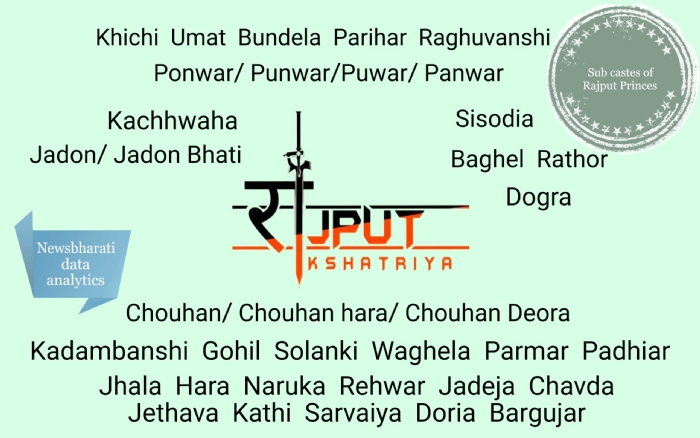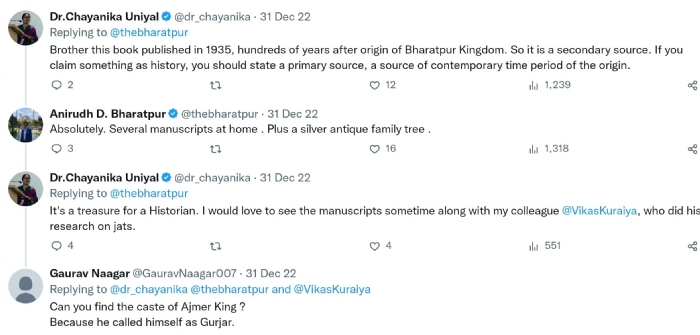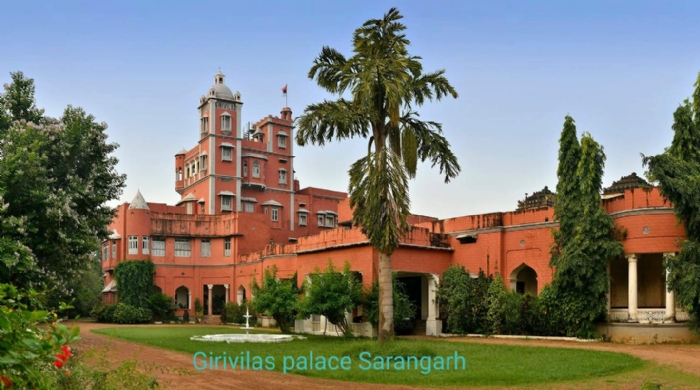Princely States: Who were the rulers?
The rulers of Princely States represent a wide cross section of society than we can imagine.
Total Views |

The phenomenon of Princely States in British empire is in a sense, a snapshot of the pre-british era of India. It can be said that it was a very distorted view, a vestige of historical political system, yet it provides some interesting insights. In this context it becomes important to see who were the rulers not as individuals but as a social class or in Indian context, as a caste. As British rulers gave importance to caste in every aspect, they have carefully documented the castes of these princes. Before trying to analyze them let us first have a broad data analysis.
The data on castes of Princes
Of the 584 Princely States, the rulers of only 56 States ( less than 10%) are Muslims, indicating that by the time British started taking control, the Islamic rule was already on the decline and effective political power was already shifted to Hindus. In the rest of 528 States, it is not surprising that the 'warrior castes', Rajput, Maratha and Kshatriya have an overwhelming presence.
But the presence of various castes among the rulers is quite illuminating.
There are many cases of upward mobility of castes reflected in the data. But more important is the significant presence of the castes which are in the OBC cagegory today and equally significant presence of Princes of current Scheduled tribes.
The caste dynamics: Rajput, Kshatriya and Maratha Princes
All these Princes can be broadly categorized as emerging from traditional 'warrior castes'. However there are significant nuances to show the dynamic nature of caste and what social sciences treat as the upward mobility trend of the caste system.
There are 329 Princes who mention their caste as Rajput. However, they will be always specific to mention the subcaste. As many as 31 subcastes are mentioned by these 329 Princes.

Just a cursory look at the names suggest the regional and clan influence on these Rajputs. As a tradition, Rajputs from Rajasthan used to prohibit marital relationships with Bundela Rajputs or with Maratha Princes. Maratha warriors tried to assert their 'Kshatriya' status right from King Shivaji the great. In the period between 1890 to 1910, The Prince of Kolhapur Rajarshi Shahu and Baroda Prince Sayajirao Gaikwad had to assert there right to be recognized as 'Kshatriya'.
Therefore it is not surprising that the Kolhapur Prince in 1935 mentions his caste as Kshatriya. But the Gaikwad of Baroda mentions his caste as 'Maratha', giving equivalence to being Maratha and Kshatriya. The same trend can be seen in other Maratha States. The Holkar of Indore mentions his caste as 'Maratha', while his original caste in Maharashtra ' Dhangar' is currently in the OBC category in Maharashtra. The ambiguity with which the Hindus repeatedly treated the meaning of caste in various British era Censuses can be seen here also since as many as 28 Princes mention their caste as 'Kshatriya', which according to scriptures is a 'Varna' and not caste.
Similar claims are asserted by various States. The memoranda on Indian States 1935 published by British Government documents the claims of various Princes.
1. The Dewas States (senior and junior) describe themselves as "founded by Tukojirao and Jivajirao of the puar (Parmar) Rajput family" who came to Malwa in 1730 with Bajirao Peshava (1st) and received the grant of these 'Parganas'. "The puars, although Parmar Rajput, lost their position as Rajputs due to intermarriages with Maratha families."
2. The Puar of Dhar State also claim their State assigned to them by Bajirao Peshava (1st) but claim to be originally Parmar.
3. The Raja of Mudhol State in Maharashtra claims " to be of Rajput origin and descended from the Rana's of Udaipur."
4. The description of Bundelakhand States notes, " The Gaharwar tribe, whom other Rajputs do not admit as being true Rajputs, is the origin of Bundelas".
In Bharatpur State, the Prince mentions his caste as Jat. The document gives the history of the origin and current status of the family. The rulers of Bharatpur claim to have been originally Jadu Rajput. Sue, a Jadu Rajput and 78th in descent from Sri Krishna, founded the village of Sinsini. His descendant Balchand having no family of his own, had sons from a Jat woman and from those childern "sprang the famous Sinsinwar Jats".
Few days ago, the current heir of that family accepted this history to be true.
He was as expected hotly trolled and it became a hot debate on Twitter for sometime.

The Scheduled Tribes Princes
Out of the 28 States where the Princes are from Scheduled Tribe according to current status of those castes, two belts of small States are obvious. One belt of 12 States is of the Bhil Princes from the Dangs area of Gujarat. They are smaller States but still 3 of them had an area of more than 100 Sq. miles. That means they were bigger than almost 350 Princely States.
For complete areawise analysis read : Princely States: a data analysis
Another belt of tribal Princes is the Khasi hills currently in Meghalay State. There were 9 States of Khasi rulers with about 80000 population according to 1931 census. Even until 1935 the area measurements of these States were not done by British Government.
But there were some significant States. One such State was Jawhar currently in Maharashtra. The ruler belonged to Mahadev Koli caste. Although there are 39 States with Koli Princes, Koli is again a big umbrella for various subcastes. There are Baria Koli, Makwana Koli in Gujarat who traditionally claim Kshatriya status but are currently in the OBC category in Gujarat. In Maharashtra, Mahadev Koli is a Scheduled Tribe. The area of the Jawhar State was 308 Sq. miles with annual revenue of more than 5 lakh Rupees in 1935. the ruller Yashwantrao Mukane who assumed charge in 1938 was well educated, served as a flight lieutenant in British air force and was elected member of Loksabha in 1952.
Another significant belt of tribal States was ruled by Rajgond Princes. The 5 States which are currently in Chhattisgadh State, were quite large. The largest of them, Raigarh had an area of 1415 Sq. miles. These States had their own traditional development models.

The Sarangarh town was known for its rainwater harvesting system developed by the Rajgond Kings at least 400 years before 1935. The main tank of 126 acres was designed to fill 28 ponds spread across the town, supply fresh water to 'ghats', irrigate 400 acres of land and to keep a moat running round the clock to supply water to the palace.
The Kallar King
Pudukottai was a State in current Tamilnadu. With an area of 1179 Sq. miles and annual revenue of 22 lakh Rupees in 1935 it was a fairly large State. Only 84 States had an area greater than 1000 Sq. miles and only 63 States had revenue greater than 10 lakh Rupees. It was unique in the sense that out of all 584 States, this one was ruled by a Prince of Kallar caste, which is Backward caste or most backward denotifed caste in Tamilnadu. The British trace the origin of the Stae to 1686. As mentioned in district gazetteer of Pudukottai "Sriranga Rayalu, a Vijayanagar prince visited the area in the seventeenth century. An elephant in his retinue went out of control causing great havoc. An enterprising Kallar by the name of Avadai Raghunatha Tondaiman subdued the pachyderm and conducted it to Sriranga Rayalu. The prince was impressed by this act of daring and conferred on Avadai Tondaiman the title of ‘ Raya ’ and granted, among other favours, a piece of land.The grant can be regarded as the seed of the Pudukkottai State, and the title can be regarded as the inauguration of Kallar aristocracy."
The Tondaiman Vamsavali, a poem in Telugu written around 1750 A.D. by a Court poet Venkanna also mentions this to be the beginning of Pudukottai State.
This implies that just few hundred years before, Kallar were not considered as a backward or criminal caste since King of Vijaynagar had no inhibition in granting a Jagir to Tondaiman.
Castes as fluid and dynamic entities
From this entire analysis it can be observed that caste staus was not a static thing. in a larger time span castes used to be upgraded or downgraded. various scholars have tried to explain these processes in various terms such as 'Sanskritization', 'Rajputization', upward mobility etc. and yet caste as a phenomenon eludes all such definitions.
But was Pudukottai the only State with backward class Prince? Not really. The Pudukottai Princely family used to have marital relationship with another very famous Kings, the 'Setupati' of Ramnad Kingdom. They had this title because historically they had the responsibility of protection and maintenance of the 'Ramsetu'. They were from Maravar caste which is another denotified backward caste in Tamilnadu. Then why we do not find that State in 1935 memoranda? Because as early as year 1803, the British annexed the State and reduced it to a 'Zamindari'. This brings us to the question of how these 584 'States' came in existence. Why 141 States had less than 5 Sq. miles area each and yet were called States and why a large State like Ramnad with an area of 2014 Sq. miles was called a Zamindari? Our upcoming article will explore this topic.

